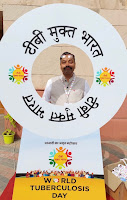[हिंदी] First-ever United Nations High Level Meeting to end TB by 2030 was held four years ago. It culminated in an important political declaration that galvanised accelerated action towards eliminating TB by 2030. With less than a year to deliver on intermediary 2022 promises, progress has been there but dismal. More importantly, latest Global Tuberculosis (TB) Report of the World Health Organization (WHO) shows that COVID-19 gave a major jolt to the efforts to fight the ancient disease forcing to reverse gains that were made in the past decade.
- Home
- Issues
- Tuberculosis
- COVID-19
- HIV/AIDS
- Hepatitis
- Non-communicable diseases (NCDs)
- Diabetes
- Cancer
- Asthma
- End tobacco
- Anti-microbial resistance
- Health security
- Gender justice
- Climate justice
- Development justice
- Pneumonia
- Malaria
- Sustainable energy
- Nuclear disarmament
- Corporate accountability
- Advocacy and campaigning Days
- Correspondents
- Publications
- Online communications
- Conference coverage
- GAMA
- सीएनएस
- About
Preventing disease and strengthening health system are key while we open up economies
[हिंदी] Although some parts of the world are reporting another rise in new COVID-19 infections, many countries are doing away with pandemic-related public health and social measures that were put in place over two years ago. Experts of Organized Medicine Academic Guild of India (OMAG) raised an alarm and called for layered safeguards with "One World One Health" approach while we rebuild a more equitable social and economic order for everyone.
Will Himalayan Indian state eliminate tuberculosis by 2023?
Two years before the pandemic had struck us, the hilly state of Himachal Pradesh in India had declared that it will eliminate tuberculosis (TB) by 2023 - two years before the national #endTB target (2025), and seven years before the global #endTB target (2030). State Chief Minister’s dedicated initiative had further galvanized the efforts towards containing the ancient disease. But are we on track?
Treatment of the world's oldest epidemic: the past, present and future
This article is dedicated to all those who lost their lives to world's most deadly infectious disease - TB - and to those who defeated it
Is it not shocking that an ancient disease that has been with human since long before the recorded history, and is preventable and treatable, still kills around 1.5 million people every year? Molecular analysis of causative microbe of tuberculosis (TB) suggests that the first infections of humans occurred as much as 70,000 years ago. But the actual cause of TB was known only 140 years ago, when on March 24, 1882, Dr Robert Koch announced his discovery of Mycobacterium - the microbe that causes TB. Even today, TB remains the leading infectious cause of death globally. 1.8 billion people (nearly 25% of the world’s population), harbour Mycobacterium tuberculosis. Every year nearly 10 million people contract the disease and around 1.5 million die from it.
No #HealthForAll without peace: Attack on healthcare facilities is war crime, must stop
[हिंदी] Slogans like 'every life matters' sound so clichéd and hollow when we see the ground reality in the ongoing Ukraine-Russia armed conflict: healthcare workers, healthcare facilities and transport are getting mercilessly attacked causing immediate and long-term damages as well as menacingly threatening the progress made on right to health in the past decades. Former Secretary General of the United Nations had condemned attacks on hospitals as war crimes.
Perils of not knowing our epidemic: Could reducing testing be counter-productive?
Think: Given the enormity with which the COVID-19 pandemic has impacted our lives for more than past two years, who will risk being caught in an Ostrich syndrome? But this is what is happening: declining COVID-19 testing in several countries is very alarming, along with sketchy genome sequencing capacity which seriously limits and jeopardizes the ability of health agencies to respond with effective and timely disease control measures.
Writing is on the wall: Pictorial health warnings reduce tobacco use
[हिंदी] More evidence from scientific research is pouring in to show that graphic pictorial health warnings on all tobacco products are very effective in preventing children and youngsters from starting to consume tobacco, and in encouraging existing tobacco users to quit the lethal addiction. This is not only great news for public health and social justice, but is also another serious blow to the tobacco industry that is selling a product that kills one out of every two of its users as per the World Health Organization (WHO) - the United Nations health agency.
Subscribe to:
Posts (Atom)








